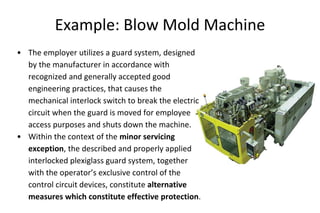Lockout Minor Servicing Exceptions
- 2. Minor Servicing Exception • Minor tool changes and adjustments, and other minor servicing activities that take place during normal production operations, are not covered by the Lockout/Tagout standard. • Three specific criteria can be used to determine if the minor servicing exception would apply to a particular activity. • ALL THREE criteria must be met; otherwise the Lockout/Tagout standard is applicable and the machine or equipment must be deenergized and all potentially hazardous energy rendered safe.
- 3. Criteria #1 The activity must be conducted during normal production operations, i.e., while the machine or equipment is actually performing its intended production function.
- 4. Criteria #2 The activity must be: • Routine: The activity must be a regular course of procedure and be in accordance with established practices. • Repetitive: The activity must be regularly repeated as part of the production process. • Integral: The activity must be essential to the production process.
- 5. Criteria #3 Employer must use alternative measures to provide effective protection from the hazardous energy, such as: • specially designed tools, • remote devices, • interlocked barrier guards, • local disconnects, • or control switches which are under the exclusive control of the employee performing the minor servicing. Using an extension tool to prevent employee injury.
- 7. Effectiveness of Alternative Measures • Alternative measures must be evaluated to ensure they provide effective protection from hazardous energy. • EXAMPLE: In order for the clearing of a conveyor package jam to meet the criteria for the “minor servicing” exception, an employer must adopt alternative measures that provide effective protection in order to avoid the LOTO requirements for machine maintenance.
- 8. Effectiveness of Alternative Measures • A CSHO should consider all of the steps taken by an employer to provide alternative, effective protection (e.g., training, disciplinary provisions, engineering controls, start-up alarms/delays, administrative provisions, near miss and related-injury data, etc.) in order to ascertain whether the alternative, including all of its steps, reliably prevents an employee from being injured by hazardous energy when performing servicing and maintenance activities under the “minor servicing” exception.
- 9. Example: Milling Machine • Vertical and horizontal milling machine operators perform minor tool changes and minor adjustments (e.g., minor belt drive adjustments; moving the coolant hose assembly close to the point of operation) that are integral to the production process by pushing the machine's stop button (without disconnecting the power supply to the machine) and perform the task in the close proximity of the start button. • All that is required to restart the machine is to push a guarded start button; however, an operator has exclusive control of this shutoff control circuit because he could easily see another person approaching the control panel and prevent her from operating the control.
- 10. Example: Milling Machine • In this scenario, milling machine operators who shut off the machine and exercise exclusive control over this control circuit would NOT need to implement LOTO. • However, the minor servicing would be covered by the LOTO standard if the alternative work method becomes ineffective (i.e., there is no alternative employee protection) and exposes employees to machine hazards.
- 11. Example: Blow Mold Machine • Blow mold machine operators perform minor un-jamming tasks, during normal production operations, at the machine’s trimmer unit on a routine and repetitive basis to remove stuck plastic containers. • This operator shuts the machines off with the control circuit switch (stop button) and she opens an interlocked plexiglass barrier guard to gain access to the trimmer’s point-of-operation area.
- 12. Example: Blow Mold Machine • The employer utilizes a guard system, designed by the manufacturer in accordance with recognized and generally accepted good engineering practices, that causes the mechanical interlock switch to break the electric circuit when the guard is moved for employee access purposes and shuts down the machine. • Within the context of the minor servicing exception, the described and properly applied interlocked plexiglass guard system, together with the operator’s exclusive control of the control circuit devices, constitute alternative measures which constitute effective protection.
- 13. Example: Monitored Power System • The automotive industry designs some processes with Monitored Power System (MPS) control systems meeting the control reliability and control component failure protection requirements of the American National Standards for machine tools (ANSI B11.19-1990) and manufacturing systems/cells (ANSI B11.20-1991). • Although control circuits are not energy-isolating devices, as defined by the standard, the use of MPS which meet the above referenced ANSI standards would provide effective safeguarding alternative methods, which constitute effective alternative protection.
- 14. Example: Monitored Power System • Thus, such an MPS may be used to protect employees who are performing minor tool changes and adjustments, and other minor servicing activities, which take place during normal production operations, provided that other remaining elements of §1910.147(a)(2)(ii) exception are met.
Editor's Notes
- Rev. April, 1997
- Rev. April, 1997
- Rev. April, 1997
- Rev. April, 1997
- Rev. April, 1997
- Rev. April, 1997
- Rev. April, 1997
- Rev. April, 1997
- Rev. April, 1997
- Rev. April, 1997
- Rev. April, 1997
- Rev. April, 1997
- Rev. April, 1997













